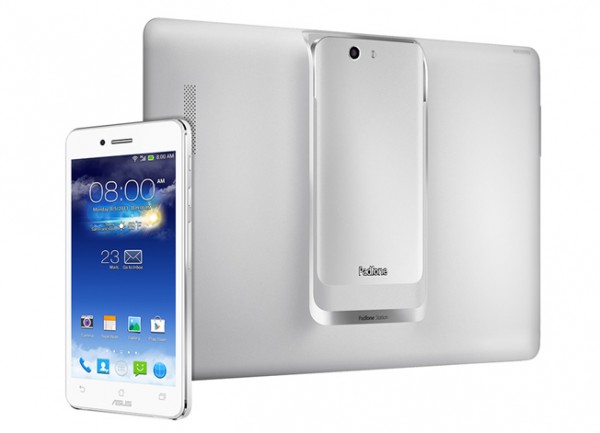Asus’ latest PadFone Infinity, released in Singapore weeks ago, comes hot on the heels of its similarly-named predecessor of no more than a few months old. Do the improvements in the Taiwanese firm’s latest phone-cum-tablet device justify the replacement? At least from the outside, nothing much seems changed.
It still has an aerospace-grade aluminium alloy uni-body frame, Full HD and a 441-pixels-per-inch 5-inch screen.
There are no big changes physically either, except for the inclusion of a diamond-cut edge, which makes it more comfortable to wrap your fingers around the brushed metal or sandblast finish on the back.
Under the hood, however, there are interesting improvements.
For starters, there’s a faster processor. The original PadFone Infinity’s 1.7GHz Qualcomm Snapdragon 600 has been replaced by the newer Snapdragon 800 clocking in at 2.2GHz.
There’s also a microSD card slot for expanding your storage. Power up the hybrid device and you’d find that the user interface has been made simpler and snazzier to give Asus a fresher appeal.
Changes to the home page. The icons have less 3D feel but they are cleaner and sharper looking.
Changes to the call page and the phone allow the user to reject the call with a message when busy.
For me, one reason for Asus to replace the PadFone Infinity so quickly would be its camera function. Things really improve with an updated image processing algorithm called Pixel Master for low light image capture.
It helps to deliver better images and overall user experience with the other features here, like a snazzier camera app interface with more scene modes and a smarter picture gallery app.
The picture gallery, for example, groups photos into Recent, Local Photos and Cloud Photos categories for quick access. As most users would look for pictures with friends and families, the gallery uses face recognition to highlight photos in the library for easy search.
As for the camera app, controlling the camera is made easier with well placed settings on the screen. There are also various scene modes that can be accessed easily via a button at the corner of the screen. The new PadFone Infinity is definitely much quicker to set up for a shot.

Simplified user interface which make it much easier to manipulate the camera.

Easier way to choose a shooting mode.
What’s also new is the introduction of Pixel Master. Pixel Master is the processor algorithm that enables the Sony sensor camera on the smartphone to use photo sites surrounding the pixel to determine the light intensity and colour through over sampling.
With this, shots taken with very low ambient light can be more accurately captured and made brighter. My tests actually show a brighter image, though sacrifices are made in terms of clarity – you do get more noise – and the image resolution is reduced from 13 megapixels to 3 megapixels.


The shot on top is using the camera’s Auto Mode with ISO800 with +2 EV compensation. The one below is using the phone’s Hi-Light mode for low light conditions at the expense of having a lower resolution image.

Shot using night scene mode. It brightens up the interior pretty well and yet holds the feel of a night scene.
The PadFone Infinity’s new camera app also includes interesting new modes such as Smart Remove. This means the camera takes multiple shots of the same scene and then removes moving objects such as pedestrians to derive a obstruction-free image.
There’s the All Smiles function as well, to ensure that group photos are not spoiled by sullen faces or those with eyes closed. Included, of course, is a 360-degree panorama function useful for taking landscape shots.


The Smart Remove feature allows the camera to clear unwanted elements within the photo such as a passing pedestrian.

The PadFone Infinity panorama function can capture a 360-degree shot but prepare to stop the shoot when there’s a huge change in light intensity. If not, there will be a abrupt change in colour such as the shot above.
The new PadFone Infinity is going for S$898 for the 16GB version, while the 32GB one will cost S$998. For those who are seeking to replace their aging phones, it is an able choice with upgraded camera features that are great for snapshots.
The control interface may not be as well implemented as the Nokia Lumia 1020 but it is still better than the average Android phone. The camera does deliver good images in most cases, especially for night shots. Only exception would be for panoramic shots in situations with different lighting conditions.
Another plus: the new Padfone Infinity works with an optional S$328 dock that turns it into a 10.1-inch tablet, with an additional 7,400mAh battery to supplement the original 2,400mAh on the phone itself.
To be sure, Asus has done a good job in upgrading the phone. However, it may have introduced new models far too often and has cast doubts on the longevity of a product’s shelf life.
Customers may find their state-of-the-art Asus phone as an old product just months after its initial launch. Would it be better to hold off a launch and incorporate all improvements, rather than to rush in there and then provide an upgrade later? Certainly, some buyers of the previous PadFone Infinity will feel that way.
As if to soften the blow, Asus has indicated a firmware upgrade for the original Padfone Infinity to Android 4.4 KitKat by the first quarter of 2014. The new version will get updated in the second quarter.










